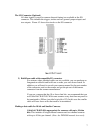16
to debounce this signal. The debounce flag can be set using the
SetTriggerSource function. If the debounce flag is set then two trigger
signals are required. One signal is set to TRIGGERP line 14 of the I/O
connector. The other is sent to TRIGGERN line 15 of the I/O connector.
By sending the signal to TRIGGERP the internal state will be set to one
state. By sending the signal to TRIGGERN the internal state will be set
to the reversed state. This can be accomplished using a SPDT type
switch.
Burst PCI Rate versus Sustained PCI Rate
A bus master can burst data across a well-designed PCI bus at 132MB/second.
Other devices on the bus can request and gain access to the bus, lowering the
sustained performance. The ability of a frame grabber to sustain data transfers
without loosing data is related to the ability of the grabber to buffer data while
another user has control of the bus. The higher the input data rate from the
camera, the more the grabber needs to buffer. The maximum transfer rate that a
grabber can sustain is related to how efficient the buffering scheme on the board
is and how efficient the PCI interface is.
EIA422-B vs. EIA-644
These are "balanced" data transmission standards that require two wires per
signal. The state of the signal at the receiver is determined by the potential
difference between the two wires and not by the difference between the signal on
a single wire and ground. Since each wire in the pair is subjected to roughly the
same transmission environment, electrical noise adds equally to both wires. This
"common mode" noise is subtracted at the receiver. This makes both of these
standards particularly useful in noisy environments. EIA-644 operates at lower
voltage differences than EIA-422 providing higher transmission bandwidths. EIA-
644 transmitters and receivers also introduce less line-to-line skew meaning that
signal integrity is better preserved even when the transmitter is EIA-422 and the
receiver is EIA-644.
Frame Rate
Refers to the sustained rate at which a camera can generate images. It is usually
the longer of the exposure time or the image transfer time.
Input Look-up Tables (LUTs)
LUTs are useful for several pixel operations that free the processor from mundane
pixel mapping. Typical uses include
• applying a gamma correction
• mapping the input pixel values to another set of values
• performing a threshold operation to produce a binary a image


















